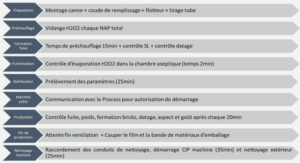Turbine Housing and Shroud Segment Geometry and Physic Mechanism
Principal HPT Components
The static structure components in this research ,They comprise the turbine housing (TH) and the shroud segment (SS) above the blade, which is a rotating structure component. The radial gap between the blade tip and the SS is named the tip clearance. In the evolution of static structures geometry, double wall static structures were widely adopted for tip clearance control (Hennecke, 1985). In that case, the inner wall is named the shroud segment (SS), facing the main gas path and the outer wall is named the housing. These two components are assembled with hooks. The housing and the shroud may be cooled using a different configuration. An example of a cooling configuration is presented in the section Shroud Segment cooling.
Tip Clearance
During a mission, an aircraft will undergo various cycles of temperature, pressure and altitude (Lattime et Steinetz, 2004). Therefore, the rotational speed and the turbine inlet temperature will increase and decrease with time. The rotating and static structures of a turbine will expand and contract due to centrifugal and thermal forces. Since the rotating and static structures have different masses and materials, their radial displacement varies at a different rate in response to the centrifugal and thermal forces. Consequently, the tip clearance can be large enough at certain times to reduce turbine overall efficiency. The build clearance is the tip clearance of a new engine before engine start (as built). The tip clearances can also greatly reduce during the mission at a condition commonly called the pinch point when the blade may rub on the shroud segment. As a result, the life of both rotating and static structures is reduced, as well as decreased engine performance .
In essence, the tip clearance has to be balanced to achieve the desired turbine overall efficiency and both static and rotating structures durability. As a matter of fact, Hennecke (1985) explains that at a tip clearance larger than 1% of blade height, for every 1% increase in tip clearance, engine overall efficiency will be reduced by 1%. Concerning the pinch point, Melcher et Kypuros (2003) explain that with blade and SS wear, material particles can partially block cooling channels, therefore, reducing cooling efficiency. For this reason, passive clearance control (PCC) and active clearance control (ACC) designs were developed and studied. Hennecke (1985) explains that PCC uses mass and material properties to achieve a faster thermal response of the rotating structures and a slower thermal response of the static structures. This author also explains that in ACC designs, a system that can be actively turned on and off controls tip clearance by heating and cooling the rotor or the casing.
First, an example of PCC that Hennecke (1985) gives is the use of a double wall casing where the outer wall supports the inner wall with hooks. The inner wall is circumferentially segmented and surrounds the rotor. The outer wall is protected by the inner wall and the radial movement of the casing is determined by the outer wall. Specific to the current research, the inner wall is a ring made of shroud segments and the outer wall is the housing. In another example, Hennecke (1985) explain that small amounts of air can be used to adjust the thermal response of the casing.
Second, for ACC designs to be viable in commercial or military gas-turbine engine, technical and economical requirements have to be met (Lattime et Steinetz, 2004). For this reason, passive clearance control designs using cooling air ducted from the compressor and a double wall casing seem to be more widely used than active clearance control designs. In any tip clearance control design, the static structures cooling efficiency will play a major role in its thermal response. The next section describes different types of cooling that are commonly used to cool gas turbine shroud segments.
Shroud Segment Cooling
Proctor et al. (1992) explain that, in the history of gas turbine, turbine inlet temperature has increased over material limits to achieve better engine performance. Therefore, the shroud segment comprised in hot sections has to be maintained below the material limit to allow the engine to work properly and increase the service life. To address this problem, many designs were developed and studied using various cooling techniques to maintain components’ temperature within the material limits. Such a design was developed by Proctor et al. They refer to impingement, convective and film cooling interactions in shroud segments. These three types of cooling have limitations when used separately in shroud cooling designs.
The first cooling type, film cooling, consists of a film of cooling air surrounding a surface to protect it from hot gas. In SS cooling, the film of cooling air is directed through the SS inner face. Since the inner face of SS is facing the main air stream, the cooling air is being constantly removed by hot gas leaking at the blade tip. Therefore, film cooling has a limited cooling efficiency.
The second cooling type, convective cooling, can be referred to a surface cooled by a moving fluid. Cooling air on the shroud outer face can be used to produce a film of cooling air on the shroud inner face. This way, the cooling air passing through SS is a convective cooling flow. However, a different configuration of cooling passages can result in a reduced cooling efficiency. There is no specific guideline in optimizing convective cooling for SS.
The third cooling type, impingement cooling, uses a liquid or a gaseous flow directed against a surface with a nozzle (Zuckerman et Lior, 2006). The nozzle has to be within a specific range from the cooled surface determined by nozzle height to nozzle diameter ratio (H/D). In other words, the cooling air passes through holes before it impacts a surface. In addition, the exit of the hole is named the nozzle. Authors agree that impingement cooling can require a large amount of air to be efficient. Since a common practice is to extract pressurized air from the compressor section for cooling purposes, impingement cooling can reduce significantly turbine overall efficiency. Therefore, a design that minimizes the amount of cooling air is required for impingement cooling to be a viable solution in the field of SS cooling.
Finally, other designs were developed to cool gas turbine shrouds trying to reach optimal cooling efficiency by minimizing the amount of cooling air ducted from compressor sections. In each design, the cooling efficiency depends on the cooling arrangement and the geometry. In other words, defining the cooling arrangement and the geometry are part of the tip clearance optimization process. The next section of this chapter will review the parameterization technique used in this research. Then an introduction to shape optimization will be made. Finally, a methodology of a correlation study will give insights on how to improve a parameterization.
INTRODUCTION |






